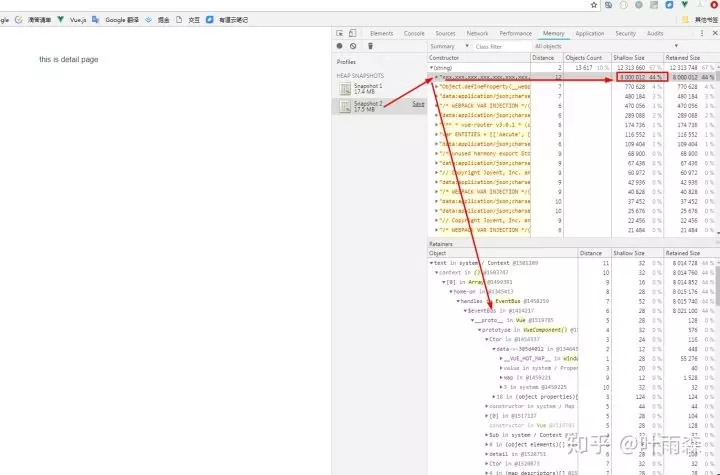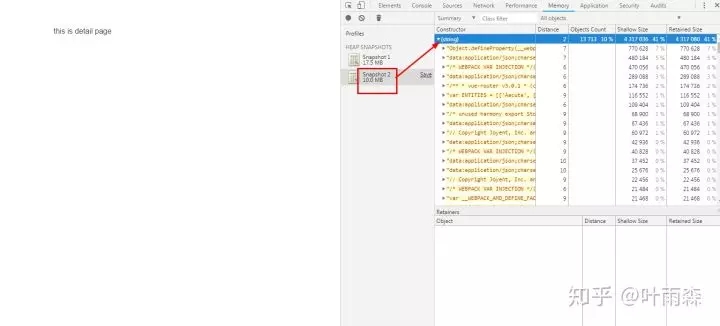Vue中使用的EventBus有生命周期
最近遇到了vue项目中的性能问题,整个项目不断的进行操作五分钟左右,页面已经很卡,查看页面占用了1.5G内存,经过排查一部分原因,是自己模块使用的eventBus在离开页面未进行off掉。我们进行下验证:
1、不随生命周期销毁
我们在home首页的代码是这样的:
created () {
let text = Array(1000000).fill('xxx').join(',') //创建一个大的字符串用于验证内存占用
$eventBus.$on('home-on', (...args) => {
this.text = text
})
},
mounted () {
setTimeout(() => {
$eventBus.$emit('home-on', '这是home $emit参数', 'ee')
}, 1000)
},
beforeDestroy () {
// 注意这里没有off掉'home-on'的订阅事件
}
// eventBus是全局的
(1)在home页时:我们拍个内存快照查看下home页的内存占用:

图1
一共17.4M我们创建出的字符串text占用了8M,这在home页没销毁时是正常的
(2)离开home页时:然后我们点击跳转到其他页面离开home页,然后再拍个内存快照:

图2
创建的'xxx,xxx...'字符串是home页面挂载在this.text上的,离开了home依然存在着,查看下面的箭头看到是存在了EventBus上,原因很明显,是我们在beforeDestroy的时候没把订阅的事件给销毁掉,而EventBus是全局的,造订阅的on的回调里调用了this.text,因此回调里的this就一直挂在了EventBus里。
2、随着生命周期销毁
created () {
let text = Array(1000000).fill('xxx').join(',') //创建一个大的字符串用于验证内存占用
$eventBus.$on('home-on', (...args) => {
this.text = text
})
},
mounted () {
setTimeout(() => {
$eventBus.$emit('home-on', '这是home $emit参数', 'ee')
}, 1000)
},
beforeDestroy () {
$eventBus.$off('home-on') // 注意这里off掉了'home-on'的订阅事件
}
// eventBus是全局的
(1)在home页时:内存快照不用多说自然是图1的内存快照
(2)离开home页时:再来拍个内存快照:

发现减到了10M,且通过内存占用看到'string'里已经没有'xxx,xxx...'的内存占用了,这说明我们销毁之后浏览器回收了this.text。
好,以上说这么多只是说明在使用EventBus时要时刻注意订阅事件的销毁。如果有一个还好,如果有5个,6个...也要挨个销毁这就比较麻烦了。话说off销毁这件重复性劳动这些都应该是机器做的事情,我们不应该去关心的。
基于以上我们自然就想到让EventBus随着生命周期销毁就行了嘛。EventBus有生命周期的特性那么就离不开在使用.$on的this的关联,每个Vue组件有自己的_uid作为唯一标识,因此我们基于uid稍微改造下EventBus,让EventBus和_uid关联起来:
class EventBus {
constructor (vue) {
if (!this.handles) {
Object.defineProperty(this, 'handles', {
value: {},
enumerable: false
})
}
this.Vue = vue
this.eventMapUid = {} // _uid和EventName的映射
}
setEventMapUid (uid, eventName) {
if (!this.eventMapUid[uid]) this.eventMapUid[uid] = []
this.eventMapUid[uid].push(eventName) // 把每个_uid订阅的事件名字push到各自uid所属的数组里
}
$on (eventName, callback, vm) { // vm是在组件内部使用时组件当前的this用于取_uid
if (!this.handles[eventName]) this.handles[eventName] = []
this.handles[eventName].push(callback)
if (vm instanceof this.Vue) this.setEventMapUid(vm._uid, eventName)
}
$emit () {
// console.log('EventBus emit eventName===', eventName)
let args = [...arguments]
let eventName = args[0]
let params = args.slice(1)
if (this.handles[eventName]) {
let len = this.handles[eventName].length
for (let i = 0; i < len; i++) {
this.handles[eventName][i](...params)
}
}
}
$offVmEvent (uid) {
let currentEvents = this.eventMapUid[uid] || []
currentEvents.forEach(event => {
this.$off(event)
})
}
$off (eventName) {
delete this.handles[eventName]
}
}
// 下面写成Vue插件形式,直接引入然后Vue.use($EventBus)进行使用
let $EventBus = {}
$EventBus.install = (Vue, option) => {
Vue.prototype.$eventBus = new EventBus(Vue)
Vue.mixin({
beforeDestroy () {
this.$eventBus.$offVmEvent(this._uid) // 拦截beforeDestroy钩子自动销毁自身所有订阅的事件
}
})
}
export default $EventBus
下面来进行使用
// main.js中 ... import EventBus from './eventBus.js' Vue.use(EnemtBus) ...
组件中使用:
created () {
let text = Array(1000000).fill('xxx').join(',')
this.$eventBus.$on('home-on', (...args) => {
console.log('home $on====>>>', ...args)
this.text = text
}, this) // 注意第三个参数需要传当前组件的this,如果不传则需要手动销毁
},
mounted () {
setTimeout(() => {
this.$eventBus.$emit('home-on', '这是home $emit参数', 'ee')
}, 1000)
},
beforeDestroy () {
// 这里就不需要手动的off销毁eventBus订阅的事件了
}
总结
以上所述是小编给大家介绍的Vue中使用的EventBus有生命周期,希望对大家有所帮助,如果大家有任何疑问请给我留言,小编会及时回复大家的。在此也非常感谢大家对脚本之家网站的支持!
您可能感兴趣的文章:
- Vue1.0学习总结(3)———vue1.0的生命周期、vue计算属性computed的使用、vue实例(vm)上方法总结、vue结合动画使用
- vue十个生命周期和v-once属性的使用(没写完)
- vue 使用eventBus实现同级组件的通讯
- 使用EventBus解决Activity生命周期使用问题
- vue生命周期及使用 && 单文件组件下的生命周期
- vue.js中生命周期与相关函数的使用总结
- vue 同级组件的通讯 使用eventBus
- vue中如何使用全局变量和全局函数
- 关于Vue的生命周期
- Expo大作战(二)--expo的生命周期,expo社区交流方式,expo学习必备资源,开发使用expo时关注的一些问题
- EventBus的使用
- vue-cli 构建的项目中如何使用 Less
- vue生命周期
- vue生命周期的理解
- 使用Vue-cli快速搭建项目
- 使用vue动态组件达到切换效果
- 使用Guava EventBus构建publish/subscribe系统
- Service之startService,bindService交叉使用时的生命周期
- EventBus 最简易的使用方式
- Vue.js使用vue-router构建单页应用
